

![]()
![]()
This Page:
Vilma Parlaghy
Louisa Parmentier-Begas
Rosa Petzel
Elizabeth Poppe-Lüderitz
Hermine von Preuschen
Doris Raab
Ottilie Roederstein
Auguste Schepp
Bertha Schrader
Liska Schroeder
Gertrud Staats
Minna Stocks
Helene Marie Stromeyer
![]()
![]()
(Alternate names: Princess Elisabeth Lwoff or Vilma Von Parlaghy or Parlaghy-Brachfeld)
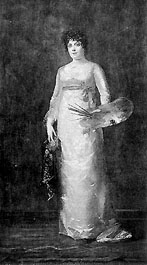
Self-Portrait--
exhibited in Rotunda,
Woman's Building,
1893 Exposition.
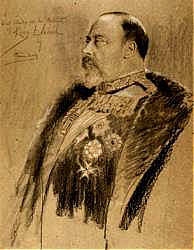
King Edward VII
(chalk study) c. 1903
--representative work.
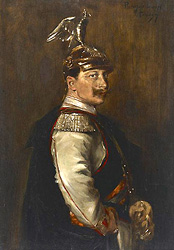
His Majesty Kaiser
William II in
Kürasieruniform--
representative work.
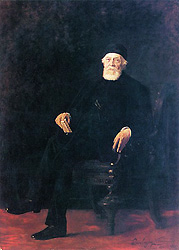
Portrait of Kossuth 1885
--exhibited in Fine Arts
Palace, 1893 Exposition.
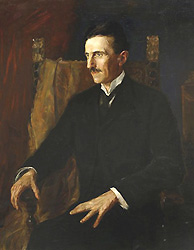
Portrait of Nikola
Tesla
--her "blue portrait," to
be shown under blue
illumination.
Elisabeth von Parlaghy or Princess Vilma Lwoff-Parlaghy, as she was more commonly known, was a portrait painter as well as an international celebrity of sorts. Born in Hungary, she studied in Budapest, in Munich with Franz Quaglio and Wilhelm Dürr the Younger, and in Venice, Florence, with Turin, soon becoming a favorite of the Court of Berlin. The "princess" married and divorced (in short order) a Russian prince, was subsequently very rich, and was well-known as an animal-lover. Her entourage and her pets, including a lion, traveled with her to luxurious hotels in Europe and America. Her last fifteen years were spent in New York. She was known for her portraits of important public figures.
![]()
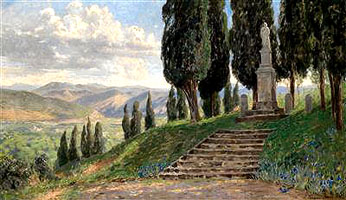
In the
Monastery Garden
--representative work.
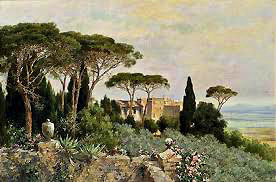
Villa Falconieri--
representative work.

Motiv aus Venedig
(1885)--may suggest
the possible colors for
A Study of Venice
(see image on right).
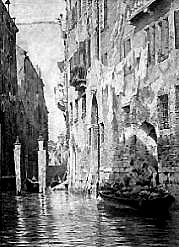
A Study
of Venice
--exhibited in the
Woman's Building,
1893 Exposition.
Louisa Begas Parmentier and her older sister Marie were born in Vienna and studied art with the landscape painter Emil Schindler and the etcher William Unger. After traveling extensively in Europe, the Orient, and Sicily, she married painter Adalbert Begas and established her studio in Berlin. Her architectural pictures and landscapes often feature Italian or Venetian themes.
![]()

Portrait
of a Gentleman
--representative work.
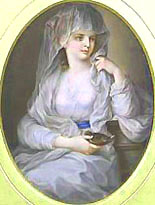
Mädchen mit Öllämpchen
1873--representative work.
Flowers (image unavailable)--exhibited in Rotunda,
the Woman's Building, 1893 Exposition.
Rosa Petzel studied art under J. Schrader, O. Begas, G. Richter, and Pauwels in Berlin. No other information is available online.
![]()

Mars and Venus--exhibited in the Rotunda,
Woman's Building, 1893 Exposition.
Elizabeth Poppe-Lüderitz was born in Berlin and studied under Gussow. She was known for her portraits. No other information is available online.
![]()
NOTE: Her name is also variously spelled Hermione and Talmann.
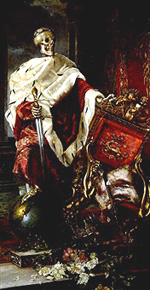
Mors Imperator [Death
of the Emperor] 1887
--representative work.
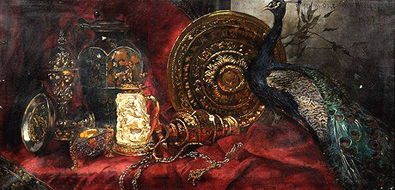
Still Life of Peacock and Ivory Tankard
--representative work.
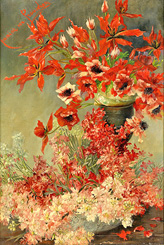
Flower Still Life
--representative work.
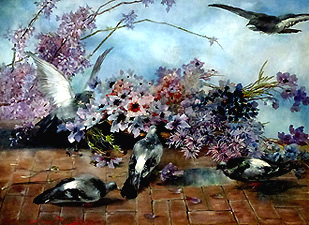
Aenemones and Pigeons--
representative work.

Still Life with Poppies
--representative work.

Indian Landscape in Bloom
--representative work.

Elaine [drifting down to Camelot]--most likely the same painting as
Titian's Pupil and Irene von Spilimberg in the Gondola of Death which
was exhibited in the Rotunda, Woman's Building, 1893 Exposition.
Artist, musician, and poet, Hermine von Preuschen was born in Darmstadt to Maximilian of Preuschen and Friederike Anna Albertine Ottilie Scheffer of Althattendorf. Beginning at age fifteen, she studied art for several years under Ferdinand Keller in Karlsruhe. She traveled to many European countries, but finally set up art studios in Munich, Berlin, and Rome; her later travels included India, Sri Lanka, and Burma. She is best known for her floral paintings. Her first (short) marriage was with Dr. Oswald Schmidt; later she married writer Konrad Zitelman or, pseudonym, Telmann. Her painting Mors Imperator caused quite a sensation at its first exhibit since some people viewed it as being critical of the elderly Kaiser Wilhelm I.
![]()

Jäger und Dirndel c. 1878
--representative work.

The Violinist c. 1880--
representative work.

Portrait after Rembrandt 1880s--
etching exhibited in the Fine
Arts Palace, 1893 Exposition.
Doris Raab was born in Nuremberg and studied etching and engraving with her artist-father Johann Leonard Raab. She often exhibited in Germany and France. No other information is available online.
![]()
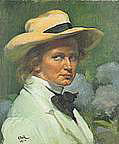
Self-portrait in a White Hat 1904--
representative work.
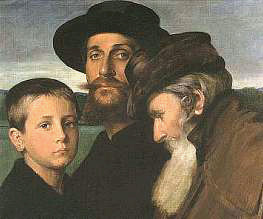
Die Drei Lebensalter 1900
--representative work.
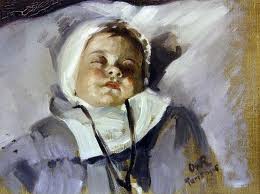
Sleeping Child 1906--
representative work.
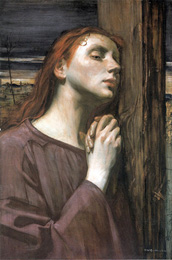
Magdalena at the Foot
of the Cross 1894--
representative work.

The Winner--
representative work

Rosen auf Violettem
Grund 1934--
representative work.
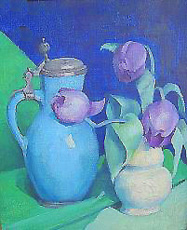
Tulips 1932--
representative work.
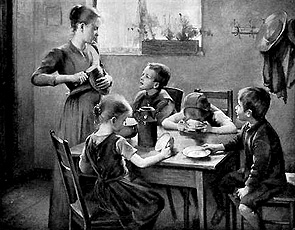
Their Daily Bread 1905--
representative work.
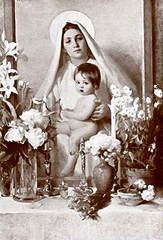
Month of Mary--
exhibited in Rotunda,
Woman's Building,
1893 Exposition.
Both a portrait painter and an illustrator, Ottilie Roederstein was born in Switzerland. Her father was a businessman who came from Germany to work for a Swiss Textile company. Her parents initially opposed her interest in studying art, but they finally allowed her to study with Swiss painter Eduard Pfyffer who was painting their family portrait. She then moved to Berlin to live with her married sister and continue studying in a special women's class given by Karl Gussow at the Berlin Academy, followed by study in Paris with Carolus-Duran and Jean-Jacques Henner. In 1891, she and her life-partner Dr. Elizabeth Winterhalter settled in Frankfurt and later opened the Schillerschule, Frankfurt's first school for girls. She successfully exhibited and accepted commissions during her entire career.
![]()
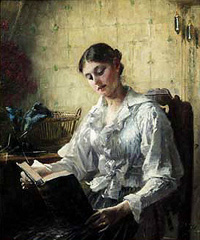
Young Woman Reading 1904--
representative work.
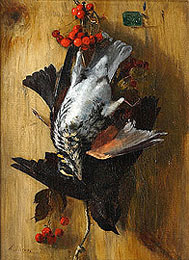
Bird Still Life--
representative work.

Küchenstillleben mit
Fischen und Zwiebeln--
representative work.

Altes Bauernpaar am Tisch
--representative work.
The Artist (image unavailable)--exhibited in
Rotunda, Woman's Building, 1893 Exposition
Auguste Schepp was a genre and still-life painter born in Wiesbaden, Germany who, in 1866, studied with Eugen Napoleon in Munich, then with Karl Ferdinand Sohn in Dusseldorf, with further studies in Freiburg, Vienna, and Paris. She became a member of the Secession after she settled in Munich in 1892.
![]()
Alternate spelling: Berta Schrader
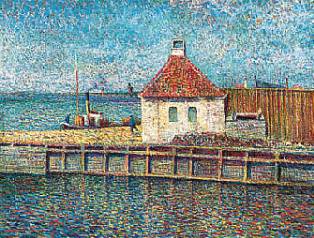
Hafenansicht--
representative work.

Holländischer Kanal 1900
--representative work.
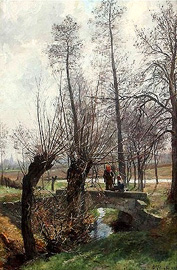
Märzmorgen 1893--
representative work.

River Elbe bei Mockritz
nächst Dresden 1894--
representative work.
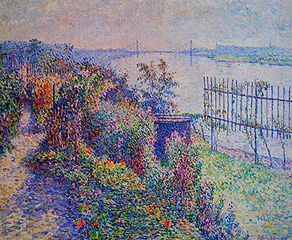
Loschwitzer Bridge
1910--representative work.
View of Dresden (image unavailable)--exhibited in
Rotunda, Woman's Building, 1893 Exposition
Bertha Schrader was born in Memel, Lithuania, but lived in St. Petersburg, Russia until 1854 when she moved to Dresden, Germany. She studied in Berlin with the miniature painter Paul Greab who specialized in architectural views and, in Dresden, with Paul Baum whose style was strongly influenced by the French impressionists Seurat and Signac. Schrader may have been living in Dresden at the time of the 1893 Exposition, but she frequently exhibited in Berlin, Hannover, Hamburg, and Bremen. Some of her work was destroyed during World War II with the bombing of Dresden.
![]()
Alternate spelling: Schröder
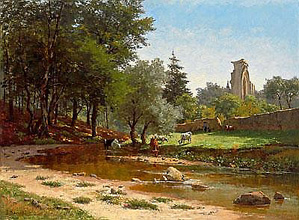
Landscape with the ruins of the Walkenried
Cloister--representative work.
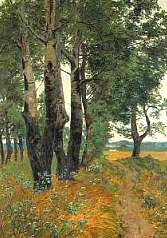
Path in the Forrest
--representative work.

Landscape--exhibited in
Rotunda, Woman's
Building, 1893 Exposition.
Liska Schroeder was born in Frankfort, Germany, and studied art in Berlin with Ludwig Dettmann, Paul Flickel, and Karl Ludwig and with Otto Strützel in Munich. She was active in various art organizations and exhibitions in Berlin-Charlottenburg from the late 19th century through 1907. Schroeder was her married name. No other information is available online.
![]()
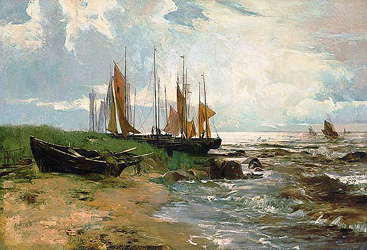
Beach with Fishing Boats on Rügen
1890--representative work.
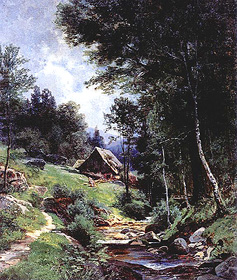
Hain--representative work.

Still Life of Summer Flowers
in Blue and White Pitcher
--representative work.

Stillleben--
representative work.
Before the Gate (image unavailable)--exhibited
in Fine Arts Palace, 1893 Exposition
Poppy Field (image unavailable)--exhibited in
Rotunda, Woman's Building, 1893 Exposition
Born in Breslau, Germany (now Poland) into the family of the wealthy merchant Adolf Staats, Gertrud Staats and her four sisters grew up in Neudorf-Kommende where her father built the large house she would live in for the rest of her life and the large studio in which she and other artists would congregate in later years. She began studying art in her teens with Hermann Bayer and a painter named Fahlbusch. Since women were not allowed into the art academies, she later took private lessons from landscape painter Adolf Dressler and then at the newly founded Silesian Museum of Fine Arts in Breslau. From 1881-83, for short periods of time, she also studied in Berlin with Hans Frederik Gude and Franz Skarbina, then returning to Breslau, to study with landscape painter Carl Coven Schirm. She traveled often, exhibiting her landscapes frequently and participating in the artist colony Dachau near Munich where she was influenced by the more modern techniques of Adolf Hölzel and Ludwig Dill. By the early twentieth century, Staats was considered one of the leaders of the Silesian landscape painters.
![]()
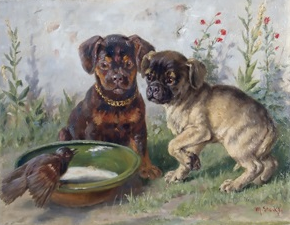
Cani--
representative work.
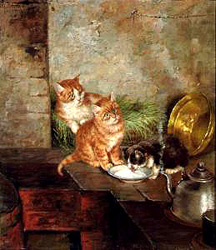
Three Cats in the Kitchen--
representative work.
Across Africa [kittens playing on map of Africa]
(image unavailable)--exhibited in
Rotunda, Woman's Building, 1893 Exposition.
Minna Stocks was born in Schwerin to the court theater singer/choir director Christian Julius Daniel Stocks and she received her first art lessons from the court painter Theodor Schloepke. In the late 1860s she went to Berlin to study with the animal painter Karl Steffeck, followed by private lessons in Düsseldorf with Ernst Bosch, and finally with Gustav Graef in Berlin again and then Jeanna Bauck in Munich. She was well-known primarily for her animal pictures.
![]()

Blumen Stillleben--
representative work.
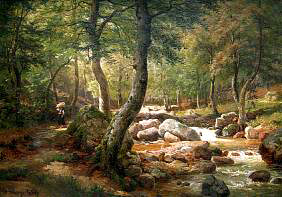
Forest Brook 1887
--representative work.
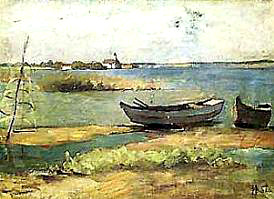
Ermatingen--
representative work.
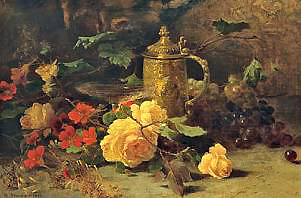
Blumenstück mit Rosen und Weintrauben
1877--representative work.
A Wreath of Roses (image unavailable)--exhibited
in Fine Art Palace, 1893 Exposition.
Born in Hanover, Hélène Stromeyer studied art under Gustav Schönleber und Hans Gude in Düsseldorf and in Karlsruhe. She lived in Karlsruhe and was known for her floral and landscape paintings.
![]()
![]()
Go to Japanese Women Painters, p. 1
Return to Women Painters Index
Return to Site Index
![]()
![]()
Text written by K. L. Nichols
Painting, top of page: Marie Konstantinovna
Bashkirtseff,
In the Studio (1881).
Return to Nichols Home Page
Suggestions/Comments: knichols11@cox.net
Posted: 6-25-02; Updated: 5-23-19